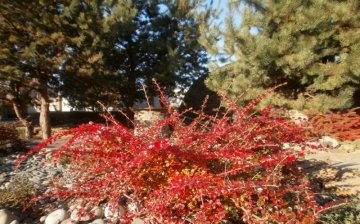Horizontal cotoneaster
The cotoneaster is very popular with gardeners. This happens thanks to a group of cotoneaster creepers, creeping along the ground with creeping branches, which they like to decorate slopes, alpine slides, retaining walls and rockeries. The main attraction of plants is strong branching, diverse growth forms and original foliage.
For our strip, that is, where winter sometimes tests us with rather low temperatures, it is better to pay attention to the horizontal cotoneaster, which is characterized by good winter hardiness, however, for the safety of the plant, it can be covered with spruce branches and sprinkled with peat, foliage or spruce needles on the root circle.
The horizontal cotoneaster is a compact shrub whose shoots are arranged horizontally, has leathery round leaves of a dark green color, which turn purple in autumn. This cotoneaster differs from many of its counterparts in its decorative appearance, which attracts the eye, especially during fruiting, in autumn.
The shrub itself is not tall, up to fifty cm tall, the flowers are hardly noticeable, but beautiful honey plants, appear from May to mid-June on last year's shoots, but the berries attract with their bright red color, hang all winter, attract birds and add decorativeness to the shrub. A cotoneaster can grow in one place for about fifty years.
The horizontal cotoneaster prefers sunny places, but it can grow in the shade floor, and fertile soils, it is not demanding for watering, it is necessary to loosen it superficially, removing weeds. It is very easy to propagate this type of cotoneaster, its creeping branches take root even without pinning, it can also be propagated by seeds (but very difficult) and cuttings.



